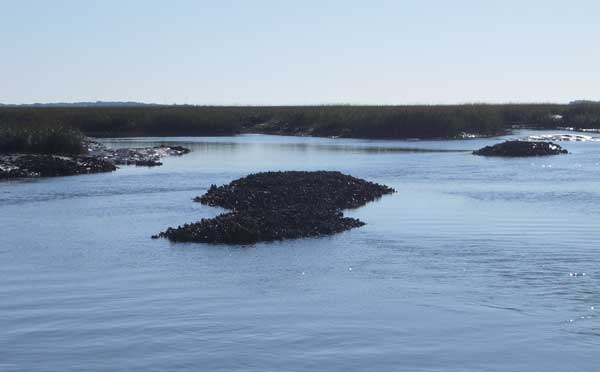
Winter is a great time to cast artificial baits to pockets of water near oyster bars and marsh grass.
The fish are not going to be used to seeing as much bait swimming around, if any, so your presentation needs to be somewhat innocent. Try to remain stealthy and cast cautiously at first, covering the water that is closest to you first before making a “big-money” cast that proves you can chuck it further than your fishing buddy.
Got a big motor? Did you know that when it is running, it makes vibrations under the water that can be heard by fish. Any noise they hear or feel that is not natural might make them finicky, so keep that in mind. Do you want to take the challenge of catching a redfish and make it even harder? Of course not, so approach your fishing spot under the power of a trolling motor, a push pole or even a paddle — to be as sneaky as you can.
Can you read the water? Let’s say you are fishing the downcurrent side of a marshy channel, so the water is rushing towards you. Rivulets will be noticeable where the current is running the strongest. Seeing rivulets takes a sharp eye, but anyone who has ever been trout fishing in the mountains can attest that these tiny current streams can absolutely hold the fish you are probing for.
At least two rivulets can be viewed in the picture that accompanies this story, with the one on the right being the closes to the boat. Your first cast should be down the right side, about one-half way up the finger of current. You are checking the end of that rivulet for fish, and you don’t want to make the mistake of casting too far —and possibly hooking another fish and spooking one that was much closer to you. Does this sound deliberate to you? That’s exactly right. This is a plan to methodically cast to and catch fish.
Cover the entire rivulet on the right side before you move the boat, or just turn your body to cast to the rivulet on the left. Once again, your first cast should be close and short, because there is no need to alert fish upcurrent of your intentions. Catch the fish that are closest, and when they are carried downstream during the fight, the fish just upstream will remain unaware of the commotion.
I love the way this particular oyster bar sets up, offering almost unlimited combinations to cast. With water on all four sides, you need to first check the closest part, casting to the point, to see if something is lurking there in the slack current. Next, cast down each side of the oyster bar, and stay alert, because there is little chance for you to “reason” which side might hold fish. Finally, alter the position of the boat so you can make an angled cast to the back of the oyster bar — now you have “covered” the water.
If your craft allows you to move up — and in this case probably only a flats boat or a kayak would allow such movement — you are ready to start casting again to the rivulets that are coming around the bend from the marsh grass. There may be a channel associated with that bend, and you want to make sure that you put a couple of casts into that area. Redfish love to rub the marsh grass, so if the water is up, bring a few casts past the grass to see if you can entice one to swim out and attack your bait.
On a recent trip, we were casting along a shell point that had deep water in front and behind it, plus one small clump of grass. The reds were schooled up tight, and there may have been 40 or 50 of them. That is enough fish for a morning full of action, if you can work them without spooking the heck out of them.
First, I made a cast to one side of the grass and retrieved — nothing. Then I cast my golden bream Exude slug worm with a gold spoon on the other side of the grass, and out shot a 30-inch redfish, just squirming across the shells to get to my lure and inhale it. Probably three casts later, I pulled another red from that grass because I had “covered” it properly.
With the water level dropping due to an ebbing tide, the grass was becoming too exposed, and we had to concentrate on the deep water on either side of the shells. The school seemed a bit stand-offish, and the slug was really causing too much commotion. We switched to floating a mud minnow under a cork where the school was likely to reappear. Sure enough, when a redfish took the mumichug, he just kept swimming like nothing had happened, and that’s when I let him know there was a circle hook attached.
I repeated my mud minnow/float trick, and it was good for two more fish. My fishing buddy’s cork was right beside mine, but it was continuously ignored. Yes sir, I was in the zone; my cork was getting dunked like it was the high school chemistry teacher in a dunking booth, and Joe Cool was lobbing in nothing but strikes.
Only the reality of a pod of hungry porpoises could break up the fishing — and they charged in, churned up the mud, and we watched in awe as they “covered the water.”



Be the first to comment